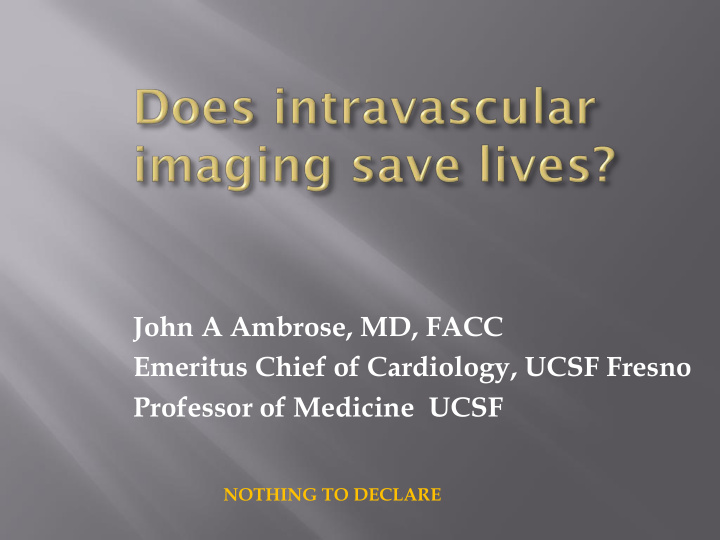



John A Ambrose, MD, FACC Emeritus Chief of Cardiology, UCSF Fresno Professor of Medicine UCSF NOTHING TO DECLARE
NO
MAYBE !!!
Pathophysiology in CAD PCI Vulnerable plaque detection
Intravascular imaging in general useful in determining the following parameters: Plaque burden, area stenosis, vessel remodeling, calcification, plaque type based on cap thickness, lipid and fibrous components Optimum stent deployment/causes of stent failure Pathophysiology of ACS-identification of plaque rupture/erosion/calcified nodule
Pathophysiology in ACS PR in 72% STEMI and 32% NSTEMI Erosion in 28% STEMI, 48% NSTEMI Ca++ Nod in 20% NSTEMI Jia et al. JACC 2013;62:1748
Higuma et al. JACC Interv 2015
Nissen et al. JAMA 2006
Pathophysiology in CAD PCI Vulnerable plaque detection
Informing the necessity of lesion preparation Choosing appropriate stent diameter and length Guiding optimal stent expansion Identifying acute complications Clarifying mechanisms of stent failure from neointimal hyperplasia, stent fracture, under expansion, thrombosis or neoatherosclerosis after Maehara et al. JACC Imag 2017;10:1487
Maehara et al. JACC Imag 2017;10:1487
While there are differences between the 2 techniques in their ability to visualize the vessel wall before and after stenting, in the 2 largest randomized trials (ILUMIEN III and OPINION), an OCT-guided PCI strategy was non-inferior compared to IVUS for both acute and long – term outcomes Ali ZA et al. Laccet 2016;388:2618 Kubo T et al. Eur Ht J 2017;18:467
You must know what you are looking at- All of the previous trials carried out by operators with extensive expertise in the use of the analyses You must use the devices- According to the NCDR, in the USA - Between April, 2009 and Sept 2010, IVUS used in 20.3% of attempted PCI of intermediate lesions (n=61,784) and FFR used in 6.1% (Dattilo et al. JACC, 2012)
(N=1686)
Pathophysiology in CAD PCI Vulnerable plaque detection
Can an intravascular device identify the specific lesion prior to it causing a thrombotic event, modify it through stenting or some other technique and thus prevent the event from occurring in the future better than optimal medical therapy alone?
Stone G et al. N Eng J Med, 2011 Lesion HR 3.90 (2.25, 6.76) 6.55 (3.43, 12.51) 10.83 (5.55, 21.10) 11.05 (4.39, 27.82) P value <0.0001 <0.0001 <0.0001 <0.0001 Prevalence* 46.7% 15.9% 10.1% 4.2% *Likelihood of one or more such lesions being present per patient. PB = plaque burden at the MLA
3-year follow-up, non hierarchical Culprit Non culprit Rates are 3-yr Kaplan-Meier estimates (n of events) Indeter- All lesion lesion minate related related 1.9% (12) 0.2% (1) 0% (0) 1.8% (11) Cardiac death Cardiac arrest 0.5% (3) 0.3% (2) 0% (0) 0.2% (1) 3.3% (21) 2.0% (13) 1.0% (6) 0.3% (2) MI (STEMI or NSTEMI) 8.0% (51) 4.5% (29) 3.3% (21) 0.5% (3) Unstable angina Increasing angina 14.5% (93) 9.2% (59) 8.5% (54) 0.3% (2) Composite MACE 20.4% (132) 12.9% (83) 11.6% (74) 2.7% (17) Cardiac death, arrest or 4.9% (31) 2.2% (14) 1.0% (6) 1.9% (12) MI
Virtual histology Plaque subtype N=2765 (N=2765 lesions in 615 pts) Fibrotic 2.5% - Mean plaque composition- Fibrocalcific 1.0% PIT 35.8% Dense calcium Fibrotic Fibrofatty Necrotic core Fibroatheroma 60.7% 6.4% 13.0% - Thick cap 38.0% - VH-TCFA 22.0% - Single, - Ca 5.4% 21.1% - Single, + Ca 0.5% - Multiple, - Ca 9.9% 59.5% - Multiple, + Ca 6.2% Stone, G et al. N Eng J Med 2011
The TCFA challenge More Unstable / Thrombosed- asymptomatic/symptomatic Plaque Unchanged Instability Stabilized Kubo et al JACC 2010;55:1590 Time (f-up) Park et al. JACC 2016;67:1772 Burke et al. Circ 2001;103:934
Can an intravascular device identify the specific plaque (TCFA) prior to it causing a thrombotic event? So far the answer is no but 3 large on-going trials are continuing to study the subject in 2 ° prevention - Prospect 2 -Lipid Rich Plaque -PREVENT
Initial presentation of CAD based on Framingham Heart Study % Lerner and Kannel. AHJ 1986;111:383
Max % identifiable NO NO Plaque erosions 1st events, (not related Imaging not performed to a TCFA) etc
Can intravascular imaging save lives? -Pathophysiology in CAD- No- not as presently utilized - In PCI- Yes- if utilized and appropriately in trained hands -VP detection- Unknown and of ? clinical relevance even with + studies
Swiss army knife
The OCTo-IVUS-Lipido-Angioscopic-FFRascope
The end
Disrupted, Lipid-rich Superficially Calcified Necrotic Core, Inflamed Eroded Plaque Nodule (TCFA) Plaque ~ 2/3 without a Thinned <5% Cap ~ 1/3* *in women (<50yrs), in non-exercise related events and in smokers, the incidence of erosion is higher Farb et al. Circulation 1996;93:1354
Recommend
More recommend